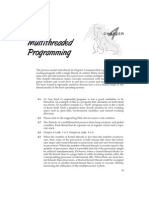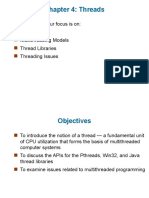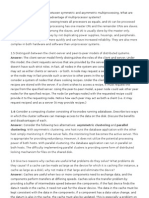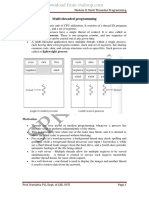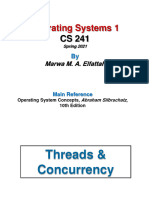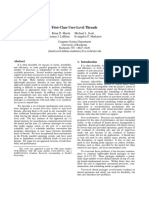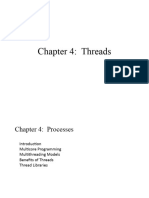Threads & Concurrency: Practice Exercises
Threads & Concurrency: Practice Exercises
Uploaded by
HilCopyright:
Available Formats
Threads & Concurrency: Practice Exercises
Threads & Concurrency: Practice Exercises
Uploaded by
HilOriginal Title
Copyright
Available Formats
Share this document
Did you find this document useful?
Is this content inappropriate?
Copyright:
Available Formats
Threads & Concurrency: Practice Exercises
Threads & Concurrency: Practice Exercises
Uploaded by
HilCopyright:
Available Formats
Threads &
CHAPTER
4
Concurrency
Practice Exercises
4.1 Provide three programming examples in which multithreading provides
better performance than a single-threaded solution.
Answer:
a. A web server that services each request in a separate thread
b. A parallelized application such as matrix multiplication where
various parts of the matrix can be worked on in parallel
c. An interactive GUI program such as a debugger where one thread is
used to monitor user input, another thread represents the running
application, and a third thread monitors performance
4.2 Using Amdahl’s Law, calculate the speedup gain of an application that
has a 60 percent parallel component for (a) two processing cores and (b)
four processing cores.
Answer:
a. With two processing cores we get a speedup of 1.42 times.
b. With four processing cores, we get a speedup of 1.82 times.
4.3 Does the multithreaded web server described in Section 4.1 exhibit task
or data parallelism?
Answer:
Data parallelism. Each thread is performing the same task, but on differ-
ent data.
4.4 What are two differences between user-level threads and kernel-level
threads? Under what circumstances is one type better than the other?
Answer:
a. User-level threads are unknown by the kernel, whereas the kernel
is aware of kernel threads.
113
114 Chapter 4 Threads & Concurrency
b. On systems using either many-to-one or many-to-many model
mapping, user threads are scheduled by the thread library, and the
kernel schedules kernel threads.
c. Kernel threads need not be associated with a process, whereas
every user thread belongs to a process. Kernel threads are generally
more expensive to maintain than user threads, as they must be
represented with a kernel data structure.
4.5 Describe the actions taken by a kernel to context-switch between kernel-
level threads.
Answer:
Context switching between kernel threads typically requires saving the
value of the CPU registers from the thread being switched out and restor-
ing the CPU registers of the new thread being scheduled.
4.6 What resources are used when a thread is created? How do they differ
from those used when a process is created?
Answer:
Because a thread is smaller than a process, thread creation typically
uses fewer resources than process creation. Creating a process requires
allocating a process control block (PCB), a rather large data structure.
The PCB includes a memory map, a list of open files, and environment
variables. Allocating and managing the memory map is typically the
most time-consuming activity. Creating either a user thread or a kernel
thread involves allocating a small data structure to hold a register set,
stack, and priority.
4.7 Assume that an operating system maps user-level threads to the kernel
using the many-to-many model and that the mapping is done through
LWPs. Furthermore, the system allows developers to create real-time
threads for use in real-time systems. Is it necessary to bind a real-time
thread to an LWP? Explain.
Answer:
Yes. Timing is crucial to real-time applications. If a thread is marked as
real-time but is not bound to an LWP, the thread may have to wait to
be attached to an LWP before running. Consider a situation in which a
real-time thread is running (is attached to an LWP) and then proceeds
to block (must perform I/O, has been preempted by a higher-priority
real-time thread, is waiting for a mutual exclusion lock, etc.). While the
real-time thread is blocked, the LWP it was attached to is assigned to
another thread. When the real-time thread has been scheduled to run
again, it must first wait to be attached to an LWP. By binding an LWP to
a real-time thread, you are ensuring that the thread will be able to run
with minimal delay once it is scheduled.
You might also like
- Amazon HR AnalyticsDocument2 pagesAmazon HR AnalyticsSwati Das0% (1)
- Operating System Exercises - Chapter 4 SolDocument2 pagesOperating System Exercises - Chapter 4 Solevilanubhav33% (3)
- Operating System FundamentalsDocument2 pagesOperating System FundamentalsBegench SuhanovNo ratings yet
- The Matrix CorebookDocument122 pagesThe Matrix CorebookKhep100% (1)
- 04 Nachreichen Von Anlagen PBF AUSL enDocument7 pages04 Nachreichen Von Anlagen PBF AUSL enManendra ChaudhryNo ratings yet
- 01 4.2.3 4.4.5 Document Control ProcedureDocument8 pages01 4.2.3 4.4.5 Document Control ProcedureYousaf RichuNo ratings yet
- Lesson 3 - The FutureDocument20 pagesLesson 3 - The FutureDiane JohnsNo ratings yet
- Threads: Practice ExercisesDocument2 pagesThreads: Practice ExercisesMarkc-Manuel Quito TiconaNo ratings yet
- AmandaNoverdinaP TugasBAB4Document3 pagesAmandaNoverdinaP TugasBAB4amanda noverdinaNo ratings yet
- CH 04Document2 pagesCH 04Aminiqueen LiuNo ratings yet
- ThreadsDocument23 pagesThreadszlatanNo ratings yet
- Assignment Os: Saqib Javed 11912Document8 pagesAssignment Os: Saqib Javed 11912Saqib JavedNo ratings yet
- Os Chapter 04Document14 pagesOs Chapter 04varnits30No ratings yet
- Module4 Thread PDFDocument8 pagesModule4 Thread PDFElena MoralesNo ratings yet
- ThreadsDocument9 pagesThreadsMd Majedul IslamNo ratings yet
- Classwork 2 2Document3 pagesClasswork 2 2Young SenseiNo ratings yet
- Chapter 3-Processes: Mulugeta ADocument34 pagesChapter 3-Processes: Mulugeta Amerhatsidik melkeNo ratings yet
- Chapter 4: Threads: in This Chapter Our Focus Is On: Multithreading Models Thread Libraries Threading IssuesDocument23 pagesChapter 4: Threads: in This Chapter Our Focus Is On: Multithreading Models Thread Libraries Threading IssuesSanjeev RNo ratings yet
- Chapter 4: Threads: in This Chapter Our Focus Is On: Multithreading Models Thread Libraries Threading IssuesDocument23 pagesChapter 4: Threads: in This Chapter Our Focus Is On: Multithreading Models Thread Libraries Threading IssuesSanjeev RNo ratings yet
- CH 4 (Threads)Document8 pagesCH 4 (Threads)Muhammad ImranNo ratings yet
- Answer:: I/O CPU CPU CPU I/ODocument8 pagesAnswer:: I/O CPU CPU CPU I/OEleunamme ZxNo ratings yet
- Tutorial 4 Solution - OSDocument6 pagesTutorial 4 Solution - OSUnknown UnknownNo ratings yet
- Module IIDocument145 pagesModule IIUtkarsh GuptaNo ratings yet
- Operating System Chapter 4Document6 pagesOperating System Chapter 4Meitei opubunqNo ratings yet
- Picothreads: Lightweight Threads in Java: 1.1 Event-Based Programming vs. Thread ProgrammingDocument8 pagesPicothreads: Lightweight Threads in Java: 1.1 Event-Based Programming vs. Thread Programminganon-679511No ratings yet
- OS MOD - 2 NotesDocument44 pagesOS MOD - 2 NotesSHALINI KGNo ratings yet
- Multithreads Lecture 3Document29 pagesMultithreads Lecture 3AfrahNo ratings yet
- Module 2 PptosDocument145 pagesModule 2 PptosvenugopalNo ratings yet
- Java Muti ThreadingDocument12 pagesJava Muti Threadingnalluri_08No ratings yet
- Multi Threaded Programming: Heavyweight Process. There Is One Program Counter, and One Sequence ofDocument39 pagesMulti Threaded Programming: Heavyweight Process. There Is One Program Counter, and One Sequence ofDhanyashree BNo ratings yet
- Chapter 4Document3 pagesChapter 4Daniel SaiguaNo ratings yet
- Homework RennerDocument1 pageHomework Rennerrsquare1No ratings yet
- 4 OS ThreadsDocument25 pages4 OS ThreadsHanNo ratings yet
- Chapter 4 ThreadsDocument3 pagesChapter 4 ThreadsAbdi AdamuNo ratings yet
- Slides 03Document62 pagesSlides 03Loai MohamedNo ratings yet
- OS Multi-Threading ConceptsDocument25 pagesOS Multi-Threading Conceptsbtsarmyforeversince2020No ratings yet
- ThreadsDocument8 pagesThreadsAbdullah DaraNo ratings yet
- OS Module2.1 ThreadsDocument43 pagesOS Module2.1 ThreadsDavidNo ratings yet
- Operating System 6Document16 pagesOperating System 6Salim Rahaman Dipu 2111267642No ratings yet
- COA Chapter 3Document9 pagesCOA Chapter 32018796.cse.coeNo ratings yet
- 5TH Operating System NotesDocument8 pages5TH Operating System NotesNeha ChinniNo ratings yet
- Lec 4 Superscalarprocessor PDFDocument23 pagesLec 4 Superscalarprocessor PDFMuhammad ImranNo ratings yet
- Chapter#03 - Threads & Multithreading ConceptDocument32 pagesChapter#03 - Threads & Multithreading ConceptManzar AliNo ratings yet
- ch4 ThreadDocument29 pagesch4 Threaddasexe7067No ratings yet
- 2 Assignment No 2 Chap 4 03042021 020349amDocument3 pages2 Assignment No 2 Chap 4 03042021 020349amatifNo ratings yet
- Operating Systems - ch5-F06Document26 pagesOperating Systems - ch5-F06Ahmad ShdifatNo ratings yet
- Operating System Module2-Lecture3 Threads: Dr. Mainak BiswasDocument11 pagesOperating System Module2-Lecture3 Threads: Dr. Mainak BiswasBiswas LecturesNo ratings yet
- Boosting Single-Thread Performance in Multi-Core Systems Through Fine-Grain Multi-ThreadingDocument10 pagesBoosting Single-Thread Performance in Multi-Core Systems Through Fine-Grain Multi-ThreadingshahpinkalNo ratings yet
- Unit 5Document29 pagesUnit 5Vanathi PriyadharshiniNo ratings yet
- Module 2Document44 pagesModule 2Gagana.mNo ratings yet
- Advanced Java Programming TithreadingDocument36 pagesAdvanced Java Programming Tithreadingcalebmengistu2019No ratings yet
- Module 2Document44 pagesModule 2shreya halaswamyNo ratings yet
- Operating Systems: Suad AlaofiDocument13 pagesOperating Systems: Suad AlaofiAmal FahadNo ratings yet
- Chapter 1: Multi Threaded Programming: (Operating Systems-18Cs43)Document39 pagesChapter 1: Multi Threaded Programming: (Operating Systems-18Cs43)Vaishak kamathNo ratings yet
- Lect 4Document26 pagesLect 4라치No ratings yet
- Week 4Document28 pagesWeek 4sananazirf21No ratings yet
- 05 ThreadsDocument35 pages05 ThreadskhaledhameadNo ratings yet
- Marsh, Scott, Leblanc, Markatos - First-Class User-Level ThreadsDocument12 pagesMarsh, Scott, Leblanc, Markatos - First-Class User-Level ThreadsJoaquin Lino de la TorreNo ratings yet
- Chapter 2 Process Management Part 2 Threads and MultithreadingDocument42 pagesChapter 2 Process Management Part 2 Threads and Multithreadingamanterefe99No ratings yet
- Java Python Interview QuestionsDocument33 pagesJava Python Interview Questionsnagardone8919No ratings yet
- Excercise Solution 3-5Document5 pagesExcercise Solution 3-5f21bscs008No ratings yet
- Unit - 3 - ThreadsDocument17 pagesUnit - 3 - ThreadsAyush ShresthaNo ratings yet
- OS Ch04 UpdatedDocument20 pagesOS Ch04 UpdatedbedouralyaqoubNo ratings yet
- Concurrent, Real-Time and Distributed Programming in Java: Threads, RTSJ and RMIFrom EverandConcurrent, Real-Time and Distributed Programming in Java: Threads, RTSJ and RMINo ratings yet
- Node.js, JavaScript, API: Interview Questions and AnswersFrom EverandNode.js, JavaScript, API: Interview Questions and AnswersRating: 5 out of 5 stars5/5 (1)
- IC-ON-LINE - CN sm34063 3672826Document8 pagesIC-ON-LINE - CN sm34063 3672826Anonymous KuTQvYTuNo ratings yet
- Beza USA Finacial ReportDocument1 pageBeza USA Finacial ReportmikebezaconsultNo ratings yet
- Design and Operation of DC Drive Using Class E Chopper: R.Spandhana, Syed Sarfaraz NawazDocument8 pagesDesign and Operation of DC Drive Using Class E Chopper: R.Spandhana, Syed Sarfaraz NawazismayilcNo ratings yet
- Industry ProfileDocument28 pagesIndustry Profilechandan sakarathmaNo ratings yet
- ATV312HU15N4: Product Data SheetDocument4 pagesATV312HU15N4: Product Data SheetAndres OrozcoNo ratings yet
- Using The Epanet Toolkit PDFDocument123 pagesUsing The Epanet Toolkit PDFOscar0% (1)
- DPC II Plus Users Manual PDFDocument190 pagesDPC II Plus Users Manual PDFJulian ZafraNo ratings yet
- ED1140158-900 (30082016 DCA Review)Document2 pagesED1140158-900 (30082016 DCA Review)mycopteraviationNo ratings yet
- rfx75 Install Magnum Ofs45Document3 pagesrfx75 Install Magnum Ofs45Geraldrum Zyzcom HdzNo ratings yet
- Be VIRAL, 7 Steps To Have More YouTube Subscribers!Document4 pagesBe VIRAL, 7 Steps To Have More YouTube Subscribers!Asif NewazNo ratings yet
- Class 11 - Maintenance Planning and Scheduling - DR - AdelDocument30 pagesClass 11 - Maintenance Planning and Scheduling - DR - AdelRajmchz100% (1)
- Mi11X - One PagerDocument25 pagesMi11X - One PagerSantosh MetraniNo ratings yet
- Basic Python Naveen: Notes byDocument172 pagesBasic Python Naveen: Notes byVamshidhar Reddy100% (3)
- Math For Programmers (Familiarize Yourself With The Basic Concepts & Upgrade Your Programming Skills)Document14 pagesMath For Programmers (Familiarize Yourself With The Basic Concepts & Upgrade Your Programming Skills)Akshay PardeshiNo ratings yet
- CS 165 - Direct Link Networks (Continued) : Slide Set 6Document35 pagesCS 165 - Direct Link Networks (Continued) : Slide Set 6test_colanNo ratings yet
- General Item Codes Item Base Id #: Console Command F04Document13 pagesGeneral Item Codes Item Base Id #: Console Command F04Hana MarischaNo ratings yet
- Endocam: The Future Is LogicDocument12 pagesEndocam: The Future Is LogicWilber AleluyaNo ratings yet
- Functions and Triggers PDFDocument23 pagesFunctions and Triggers PDFXie PeiyiNo ratings yet
- Emotiv SDK User ManualDocument87 pagesEmotiv SDK User ManualJulio VogelNo ratings yet
- Automated Grading System For Teachers and StudentsDocument2 pagesAutomated Grading System For Teachers and StudentsAnone Anone0% (1)
- Activity 11 Chocolate MilkDocument2 pagesActivity 11 Chocolate Milkruvina monteiroNo ratings yet
- 678678Document6 pages678678Navdeep KaurNo ratings yet
- Gas Sensor MQ5 - Epro Labs WiKiDocument2 pagesGas Sensor MQ5 - Epro Labs WiKiManish KumarNo ratings yet
- ArrayDocument3 pagesArrayRachana Reddy SunkiNo ratings yet
- Hat Universe + NetlessDocument4 pagesHat Universe + NetlessGLTNo ratings yet









